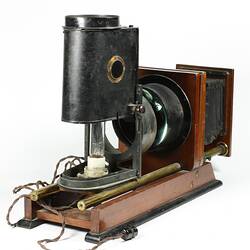Summary
Projector used to view lantern slides. It has been converted to electric illumination.
Andrew Ross was a scientific instrument maker and optician working in London from 1830 till his death in 1859. On his death the business was taken over by his son Thomas under the name of A. Ross & Co. and from from circa 1870 as Thomas Ross. Over time the business advertised lanterns as well as photographic equipment in conjunction with its optical instruments and lenses. Lenses were manufactured by the firm into the 1970s.
While the invention of the magic lantern is generally seen to be in the 17th century, its greatest popularity as an optical projector spans the late 18th century to the early decades of the 20th century. It was used both as a means of entertainment and education.
This lantern projector is part of the Francis Collection of pre-cinematic apparatus and ephemera, acquired by the Australian and Victorian Governments in 1975. David Francis was the curator of the National Film and Sound Archive of the British Film Institute as well as being a co-founder of the Museum of the Moving Image in London, which was operational between 1988 and 1999.
Physical Description
Rectangular wooden base, body front and slide holder. Brass detailing. Brass sliders fixed to base for bellows extender and lantern body. Black cloth concertina bellows extender. Japanned illuminant and condenser housing. Aperture at top of illuminant housing for chimney. Single viewing apertures covered with red glass into illuminant housing found on either lateral side of body. Illuminant housing can be raised and locked into place. Electric illuminant, including globe and cord. A white name plate is fixed onto the front of the body by 4 single slot screws in each corner.
More Information
-
Collection Names
-
Collecting Areas
-
Acquisition Information
Loan & Subsequent Donation from Australian Film Institute (AFI), Mr David Francis, by Nov 1990
-
Collector
Mr David Francis, London, Middlesex, England, Great Britain, 1990
-
Manufacturer
Mr Thomas Ross, London, Middlesex, England, Great Britain, 1890-1920
-
Inscriptions
Rectangular plaque on front of lantern body: 'ROSS/LONDON.' Paper sticker on front of lantern body: '466'
-
Classification
Communications, Audio-visual technology, Image production equipment
-
Category
-
Discipline
-
Type of item
-
Overall Dimensions - Closed
620 mm (Length), 211 mm (Width), 310 mm (Height)
Object Dimensions is for the projector with lens unextended.
-
References
[Book] Robinson, David, et al. 2001. Encyclopaedia of the Magic Lantern., 2001, 258-59 Pages
-
Keywords
Lantern Projectors, Magic Lanterns, Photographic Enlargers, Pre-Cinema Moving Images, Projectors




